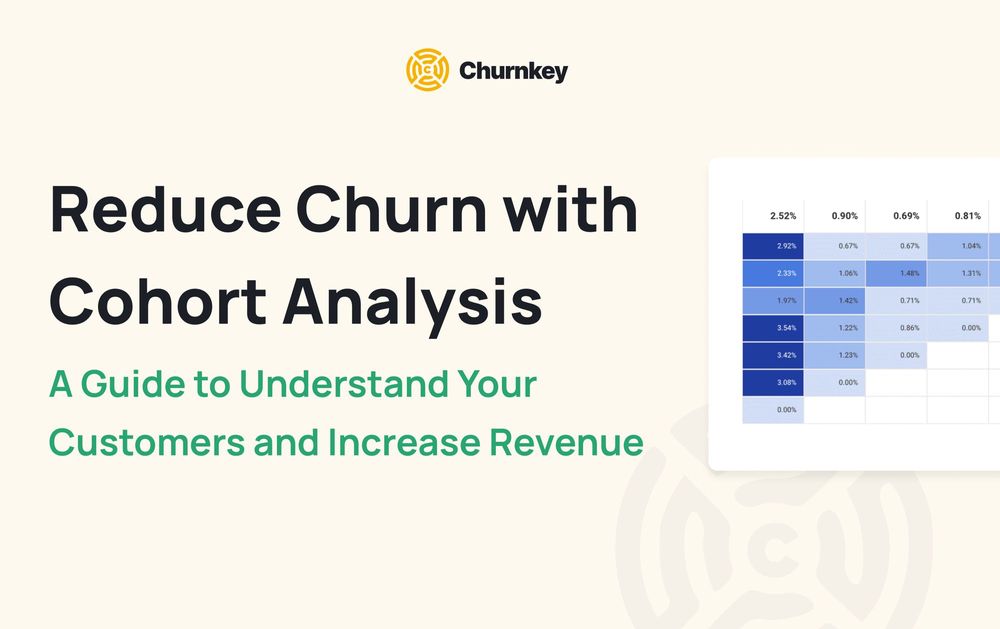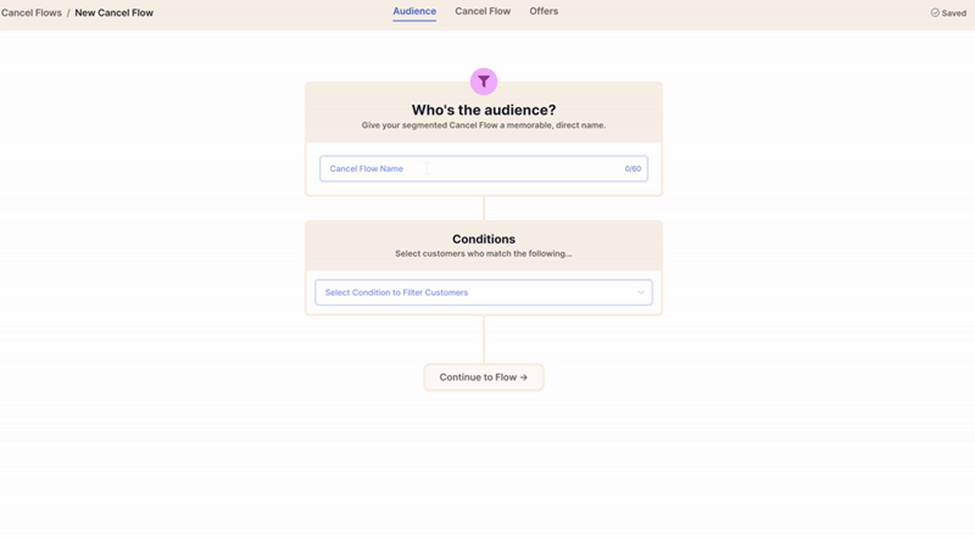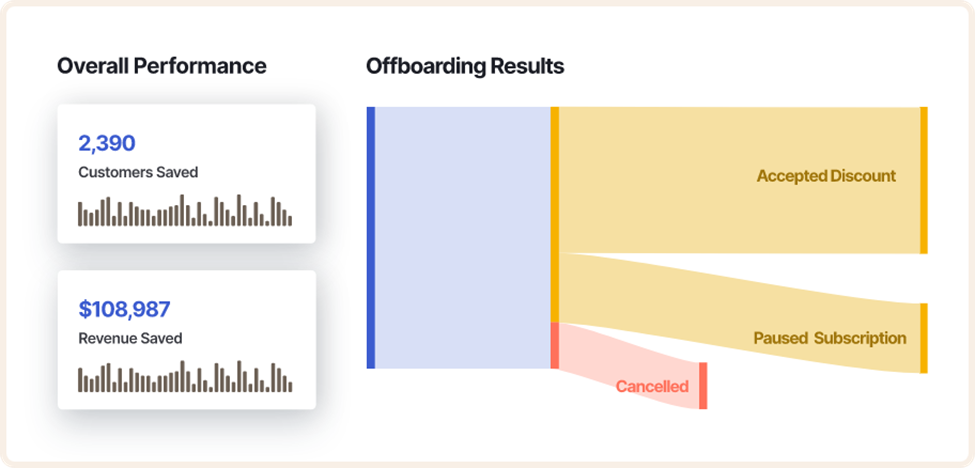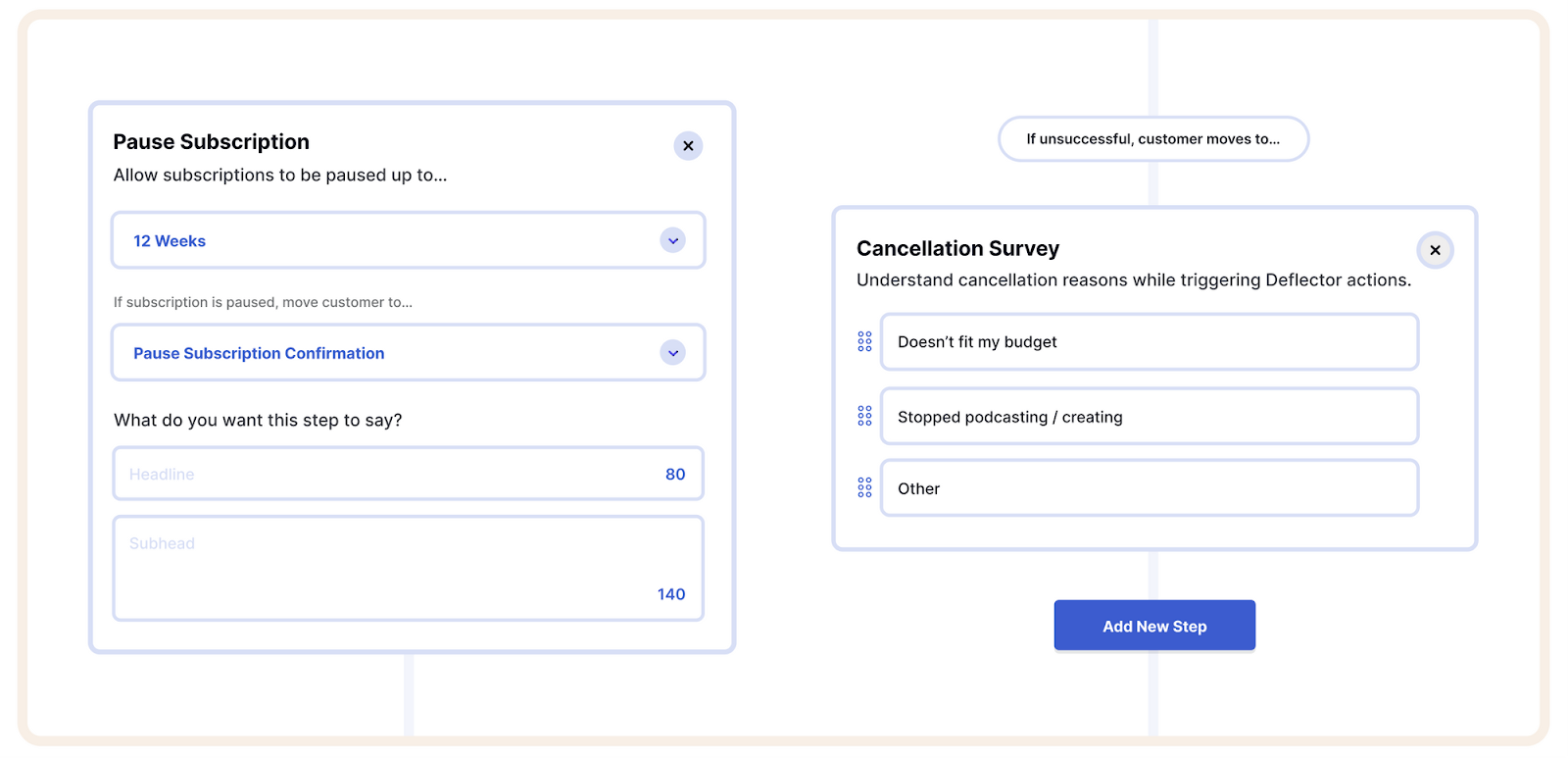Using Cohort Analysis To Reduce SaaS Churn
Learn how to understand cohort analysis and use it to improve your subscription metrics.

Using Cohort Analysis To Reduce SaaS Churn
Cohort analysis is one of the key ways to understand and reduce SaaS customer churn. Learn how to understand cohort analysis and use it to improve your SaaS metrics.
Cohort analysis is one of the key ways to understand and reduce SaaS customer churn, the rate at which customers cancel their subscriptions over time. However, there are many different sides to SaaS cohort analysis. Product managers, founders and product marketers can often feel at a loss once they need to categorize users into cohorts or crunch numbers.
At Churnkey, a tool for reducing SaaS churn through effective offboarding, we believe that cohort analysis shouldn’t be complex. It should be accessible to everyone — not just data scientists — who want to use analytics to grow their SaaS business.
In this article, we’ll provide a simple definition of what SaaS cohort analysis is, the different types of cohorts you can analyze, the importance of this sort of analysis, and how to use our features to help facilitate SaaS cohort analysis.
What Is Saas Cohort Analysis?
In product management, a cohort is a segment of customers sharing common traits and characteristics. Cohort analysis refers to the study of how these cohorts change over time, over your customer lifecycle. Here are some cohort types that you can analyze:
- Acquisition-based and time-based cohorts - A cohort based on when users have subscribed to use your product. For instance, you might want to analyze and compare acquisition cohorts based on the season they’ve purchased a subscription in, which could show trends in seasonal churn or customer growth.
- Behavioral cohort - A cohort based on shared behaviors and interactions. An example of this is to segment your customers by engagement rate, and identify power users over a certain time period. A behavioral cohort analysis may also provide actionable insights into which features are the most heavily used. You can then devise ways to maximize the chances of connecting the right customers to the features they’ll love through effective onboarding (e.g., through tooltips, newsletter tutorials, etc.).
- Subscription plan cohort - These are cohorts categorized by the plan they’re in. You can do a cohort analysis in the offboarding phase and integrate it in the product cancel flows to find ways to decrease churn. You can even use Churnkey to implement discounts, and other ways to improve retention rate.
- Revenue cohort - Alternatively, you can also analyze a cohort based on their lifetime value or average revenue provided over time. Remember, not only do SaaS products have subscription plans, but some of them can also have add-ons that are valuable money makers. For instance, Keywords Everywhere employs a credit-based subscription plan, where you get 100,000 for $10 that lasts for 12 months. Revenue cohort analysis can reveal insights into which add-ons are your most lucrative ones.
- Geographic cohort - Your customer behavior depends heavily on the country or region that they live in. Each area comes with its own taxation schemes, regulations, and even payment processing mechanisms. You could stand to retain a far greater number of customers simply by adapting your SaaS offerings to local regulations.
- Voluntary and involuntary churn cohort analysis - When conducting churn cohort analysis, SaaS customers can be split into voluntary and involuntary cohorts.
- Voluntary cohorts are made up of customers that churned voluntarily, they decided to cancel their subscription with a click of a button. For whatever reason, they decided to cancel or downgrade their subscription because of personal preferences.
- Meanwhile, involuntary churn arises when a customer’s payment fails. This could occur due to a whole host of reasons: declined and expired credit cards, erroneous payment info, and insufficient funds. The customer did not want to cancel or downgrade their plan. You can resolve the issue of involuntary churn by ensuring that your payment infrastructure is resilient and anticipates issues ahead of time.
Of course, effective cohort analysis can be done in multiple stages and involve analyzing cohorts across several data points. For example, you might want to see the differences in spending behavior between customers from various subscription plans. This can then be followed by a time-based analysis to see which seasons have customers with the highest Lifetime Value (LTV) and/or lowest churn rate.
Why Lifetime Value (LTV) Matters
Lifetime value is the key to revenue cohort analysis, organizing SaaS customers into this cohort is vital. Knowing the LTV of a customer will help you understand how much it costs to lose them and decide whether you should retain them. Furthermore, companies use customer LTV to project their revenue growth and compare current customer LTV to customer acquisition costs.
Essentially, LTV is an estimate of how much revenue a specific customer will return to a business. Its calculation factors in the average value of a sale, multiplied by the number of transactions per year and the number of years that you retain the customer.

For example, if you have a customer who pays $100 per month and stays for 3 years, then their LTV is $100 x 12 x 3 = $3600. And if they’re about to cancel, you know that they’ve already made 36 transactions with you. So, it’s not too difficult to convince them to stay on.
That’s why if you run a SaaS business, you should be aware that it’s far more expensive to pursue new customers than it is to maintain a relationship with your current ones. Don’t fall into the same trap as other SaaS companies. Reducing churn is a far more effective way to extend LTV and therefore your revenue projections. As a result, your company valuation will improve substantially
MRR Churn Cohort Analysis
The objective of reducing your SaaS churn rate is to increase your Monthly Recurring Revenue (MRR). The more churn you experience, the lower your MRR, and the lower your company’s valuation.

It might not seem as though losing a few customers is very important. But all that churn can add up over time. In the example above, you can see how one of our clients supercharged their revenue growth using Churnkey.
All they needed to do was improve their cancellation flow by analyzing cohort behavior. Then, during the cancellation flow, they presented their customers with custom offers based on churn cohort analysis.
Why Is Saas Cohort Analysis Important For Businesses?
SaaS cohort analysis provides an overall understanding of how customers use your features and helps you figure out how to grow as a business:
- SaaS cohort analysis can reduce your overall churn and increase retention. After all, it’s much costlier to acquire a customer than to retain existing ones. You can then implement your learnings in the onboarding and offboarding phases through tools like Churnkey.
- At the same time, it can also show how different cohorts engage with your SaaS platform and find behavioral patterns. You might uncover a flow that can increase product use by more than 1000%.
- Through effective SaaS cohort analysis, you can also discover which pricing plans to highlight and which ones to revise. For instance, do you need a free plan or a free trial? Will removing the free plan lead to a net loss, or will the conversions to the paid plan offset the churn? These are questions that can be answered through cohort analysis.
- SaaS cohort analysis can also help you refine your marketing or product strategy for the reasons mentioned above.
How to Analyze Cohort Data
To analyze cohort data for SaaS, you need to ask the right questions about the data. The goal is to obtain information that you can implement in your business.
First, you need to ask a pertinent question. In your case, you probably want to reduce churn. Cohort analysis will help you achieve this, but you need to enter the right parameters.
Your next step is to identify data about the cohort that is relevant to you. If your goal is to reduce churn, then you want to accumulate data on subscription cancellations. Relevant data might include things like cancellation journeys, LTV data, and so on.
Next, you need to define the specific cohort of SaaS customers that you want to analyze. As we mentioned earlier, there are quite a few different ways to slice your customers. It’s best to experiment with the different filters to figure out the cohorts where you are losing the most customers.
That said, you might do a better job of retaining certain cohorts than others, even if the cohorts you retain well are smaller in size. It also depends on your retention strategy. With a proper cancellation flow, you’ll keep far more customers than if you just try to hide the cancel button.
Now, let’s look at how to implement cohort analysis for SaaS businesses. We’ll go over a specific example of how to analyze cohort data.
How To Use Cohort Analysis To Reduce Churn And Increase Retention
Analytics tools like Google Analytics and Panelbear provide insights into how customers interact with your domain and other analytics that can be used for customer cohort analysis. Onboarding and offboarding tools like Nickelled and Churnkey show how you can reduce churn and increase retention. Hotjar shows the online behavior of people on your website. All of these tools can significantly help reduce time, money and energy spent executing SaaS cohort analysis.

For example, in the image from Google Analytics, you can see the engagement rate of various time-based cohorts (February 2018) over a period of time (7 days). Essentially, the engagement rate dwindles as the days pass, but the February 22 cohort gets to 0% at the Day 7 mark, while all of the February 28 cohort leaves after the first day. You can triangulate these findings with other data to uncover insights behind this difference in engagement rate progression.
Using Churnkey, we’ll demonstrate how to use SaaS cohort analysis and implement it into your cancel flow to prevent customers from canceling their subscriptions.
Here’s a scenario. Let’s say that you’ve discovered some behavioral insights from a very valuable cohort/segment that we’ll name “VIP”, who we define as:
Customers who have been subscribed for over a year and are on either of your two most expensive plans.
With our tools, you can define this cohort by entering relevant conditions. In this case, there are two main ones.
- Subscription Age (months) is greater than or equal to 12,
- AND their Subscription Price is greater than or equal to X (insert your plan price accordingly).

Churnkey automatically creates a new audience that you can use to build a unique cancel flow for this particular cohort/segment. You can send:
- Dynamic offers with copy created specifically with that particular cohort in mind.
- Subscription pauses to encourage customers to use the tool at a later date.
You can also integrate SaaS cohort analysis during the offboarding phase by simply asking customers why they’ve decided to stop using your product. Using their answers and insightful offboarding analytics, you can analyze and find ways to reduce churn for certain cohorts.

Saas Cohort Analysis Reveals Valuable Data You Might Have Overlooked
SaaS cohort analysis may be a cumbersome process, especially for marketers, product owners and founders who’d rather focus on initiatives that don’t involve getting deeply into data, but categorizing customers into cohorts reveals data that may help you scale business growth.
Finally, SaaS cohort analysis does not need to be needlessly complex or take hours to do. You don’t need to be a data scientist who can easily locate a number in a Sheets file with thousands of cells. You can use tools like Churnkey to significantly save time and energy when it comes to understanding why customers have stopped using your SaaS tool.
Here's an example of one of the many insights that Churnkey provides.
Analyze Cancel Flows With Churnkey
Looking at a table full of retention rates is useful, but it takes a lot of time to parse through the data. And even though a graph like the one below is better still, it still won’t tell you the full story.
Imagine if you could peer right over the shoulder of a customer who attempts to cancel their subscription. You would learn a lot more from that than you would from aggregate data, wouldn’t you?

You’re much better off studying cancel flow session recordings than trying to guess what happened. Churnkey gives you access to precise, granular data.
Once you’re armed with these insights, you can improve your cancel flow substantially. Churnkey will be right there with you. Use our tools to dynamically offer deals tailored to a specific cohort. You can trigger deals based on individual customer factors including loyalty, LTV, subscription tier, and much more. This is what makes cohort analysis so powerful.

For instance, imagine that a customer is on a monthly subscription. They click to cancel their subscription, as a result, Churnkey shows them an offer that you customized specifically for customers like them. If you use the right copy, offer, and branding, you could wind up winning the customer back.
In a normal cancellation flow, they’d just click the button. You might lose them forever. On average, our customers reduce churn by 34% and increase LTV by 26%.
If you’re ready to take action and optimize cancellation flows to retain customers,get started with Churnkey today.



